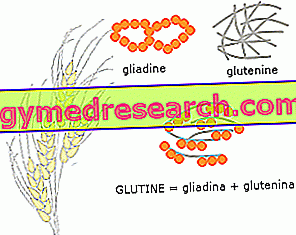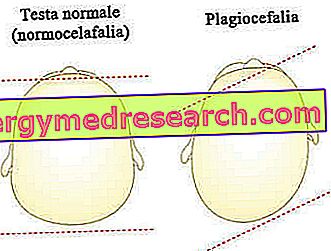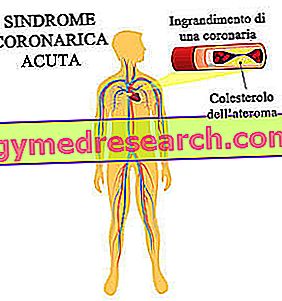Generality
What is gluten?
Gluten (from the Latin gluten = glue) is a food complex consisting mainly of proteins.
It is a peptide compound typically found in some cereals, especially in wheat or wheat and the like (spelled, spelled, triticale, kamut), but also in rye, barley and often oats.

Gluten helps to give the elastic properties necessary for natural leavening, which occurs thanks to the energy metabolism of Saccharomyces cerevisiae (biological starter).
However, in predisposed subjects, the intake of this nutrient triggers more or less serious adverse reactions (eg celiac disease of celiacs and non-celiac gluten sensitivity).
Structure
How is gluten made?
Gluten appears as a viscoelastic network (elastic, sticky) capable of combining cohesion and elasticity.
Gluten consists of two protein classes:
- Gluteline (called glutenins in wheat)
- Prolamines (called gliadins in wheat, ordeine in barley, secaline of rye, avenines of oats, etc.) *.

- Albumins (9%)
- Globulins (5-7%).
* Note : The toxicity of avenins in people who are hypersensitive to gluten depends on the type of cultivar, because the prolamin immunoreactivity are different depending on the variety of oats in question. Furthermore, many oat-based products are crossed with other cereals containing gluten.
Proving and Baking
Role of gluten in leavening and baking
Bread making is made possible by the presence of gluten, which as we have already said is formed following the hydration and mechanical action of the dough.
- When we add water to wheat or wheat flour, the gliadins (formed by a single protein chain) begin to associate forming fibrils (small and thin fibers), which give extensibility to the gluten mass.
- At the same time, even the glutenins (composed of different protein subunits) are assembled, giving rise to fibers of greater dimensions and forming a stable and very cohesive structure, which gives the dough consistency and a certain extension resistance.
- The degree of leavening of the dough therefore depends on the proportion between the content in gliadins and glutenins of the flour. The ratio between the two proteins depends on the variety of wheat considered and gives the gluten the ability to deform and resist distension. Shortly:
- If the former prevail, the glutinous reticulum can extend, and therefore rise more.
- If glutenins prevail, the mesh is more rigid, extends less and consequently the leavening is less.
- During the mechanical kneading action, the gliadin fibrils and the glutenin fibers begin to intertwine, forming a three-dimensional mesh (protein content 75-85%), which incorporates starch granules (10-15%), lipids ( 5-10%), small amounts of mineral salts, water (which gluten can hold up to 70% of its weight) and air bubbles which, as we shall see, are very important for leavening and bread making.
- Adding the yeasts ( Saccharomyces cerevisiae ) in the right quantities, in the presence of a suitable temperature, the bases are thrown for the fermentation of carbohydrates (starch or glucose) and the consequent production of alcohol and carbon dioxide.
- Alcohol and carbon dioxide are combined in air bubbles which, when absorbed by gluten, gradually expand and spread the gluten meshes. This is the phenomenon that allows to increase the volume of the dough.
- Subsequently, during cooking takes place the denaturation / coagulation of proteins and the gluten - which loses elasticity - irreversibly stabilizes the structure and shape of the dough, which becomes "food" (bread, focaccia, pizza, etc.).
Gluten in food
Which foods contain gluten?
Gluteline and prolamine are typical of all cereals, but their amino acid composition is variable; this difference affects the ability of the various flours to form a whole series of bonds between their own protein chains and to make the glutinous reticulum more or less stable.
The durum wheat gluten, for example, is more resistant and tenacious than that of soft wheat, so much so that the flour of the latter can be used for the preparation of bread and panettone, while durum wheat flour ( called semolina) is ideal for the preparation of pasta.
The proteins of some cereals, such as rice and corn, fail to form gluten, which is abundant especially in wheat (it contains up to 80% of glutenin and gliadin on the total protein).
| GLUTEN CONTAINING FOODS | GLUTEN-FREE FOODS |
| Wheat (wheat), Barley, Rye, Oats *, Spelled, Kamut, Spelta, Triticale | Amaranth, buckwheat, corn, millet, rice, legumes (beans, lentils and peas), chestnut, potato, sesame, soy, sorghum, tapioca |
| (*) According to some studies, if introduced pure, ie not contaminated with gluten during processing, oats would not be harmful to most (99.4%) of celiacs. Bibliography: Can oats be taken in a gluten-free diet? A systematic review. Scand. J. Gastroenterol. Vol. 42, No. 2, pages 171-178. | |
Chemical bonds responsible for the structure of gluten
The chemical bonds responsible for the structure of gluten are very complicated and numerous, and depend on the different organization of gliadins (monomeric and globular structure) and glutenins (fibrous and polymeric structure):
- Hydrogen bonds between the negatively charged groups of proteins (ac. Glutamic and aspartic) and water molecules
- Disulfide bridges among cysteine residues
- Ionic bonds between salts and glutamic acid and lysine
- Lipoprotein complexes between glutenins and lipids
- Electrostatic bonds between the water absorbed by starch (36%) and amino acid residues.
When the dough is raw, all these bonds are not stable, so much so that we can shape it to our liking by breaking them and building new ones; their stability is reached during cooking, which involves the loss of water and the stiffening of the glutinous reticulum.
Production
Gluten isolation from flour
Gluten can be isolated from the rest of the flour; this process can take place both on an industrial and a household level.
Homemade gluten production
Homemade gluten production is simple:
- Mix the flour with cold water
- The dough is subjected to a continuous washing (always in cold water) completely eliminating the starch (the washing water must be clear)
- Note : recovering the water it would be possible to extract the starch by drying.
- See the video recipe for seitan at home
Industrial production of gluten
- Industrial production is more efficient.
- The flour is diluted and kneaded in cold water
- By centrifugation, the gluten is separated
- Thanks to a press, up to 65% of the water is pressed away
- Through an atomizer nozzle, what remains is sprayed into a drying chamber (not too hot) where the remaining water evaporates, leaving only 7%
- Cooling and grinding follow.
Adverse reactions
Gluten, due to its high amino acid content, is considered very nutritious; in particular, it constitutes an extremely important protein source in vegan nutrition.
However, there are some people who must absolutely do without it, as they are hypersensitive to gluten.
Gluten-related disorders include:
- Celiac disease (CD)
- Non-celiac gluten sensitivity (NCGS)
- Wheat allergy
- Gluten ataxia
- Dermatitis herpetiformis (DH).
Their incidence is currently increasing in most geographical areas of the world. This is perhaps due to:
- To the increasing westernization of the diet
- Increased use of wheat-based foods typical of the Mediterranean Diet
- To the progressive replacement of rice with wheat in many countries of Asia, the Middle East and North Africa
- To the recent development of new types of wheat with a greater quantity of cytotoxic peptides
- Higher gluten content in bakery products (to reduce dough rising time)
- Increased diagnostic investigations.
Gluten and celiac disease
What is celiac disease?
Neglected celiac disease (subjecting the body to continuous exposure to gluten) can evolve into so-called celiac disease (CD).
The CD is not only a gastrointestinal disorder, where it causes inflammation and atrophy of the intestinal villi, but can involve different organs causing non-gastrointestinal symptoms.
Sometimes celiac disease is completely asymptomatic, delaying the diagnosis. A further diagnostic difficulty concerns the absence of serological markers (tissue anti-transglutaminase [TG2]), which can hide minor lesions of the mucous membranes (without atrophy of the intestinal villi).
CD affects about 1-2% of the general population, but most cases remain unknown, undiagnosed and untreated, with the risk of serious long-term complications.
Complications of celiac disease
Untreated celiac disease can cause:
- malabsorption
- Quality of life reduction
- Iron deficiency and anemia
- Osteoporosis
- Increased risk of intestinal lymphomas
- Increased mortality.
Co-morbidity of celiac disease
The CD is also associated with some autoimmune diseases such as diabetes mellitus type 1, thyroiditis, gluten ataxia, psoriasis, vitiligo, autoimmune hepatitis, herpetiform dermatitis, primary sclerosing cholangitis and more.
Symptoms of celiac disease
Celiac disease with "classic symptoms" includes some intense gastrointestinal reactions:
- Chronic diarrhea
- Abdominal distention
- malabsorption
- Loss of appetite
- Development impairment.
However it is currently the least common pathological form and mainly affects children younger than two years.
The CD with "non-classical symptoms" is instead more common and occurs in older subjects (over 2 years), adolescents and adults.
It is characterized by milder or even absent gastrointestinal symptoms and a broad spectrum of non-intestinal manifestations, which can involve any organ in the body; very often it can be completely asymptomatic in both children (at least 43% of cases) and adults.
For more information on celiac disease, see the dedicated article.
Gluten sensitivity NOT celiac
As for the adverse reactions triggered by gluten intake, in addition to celiac disease, there is a second condition called non-celiac gluten sensitivity.
In this disorder, the ingestion of gluten causes symptoms similar to those of celiac disease, but in the absence of specific diagnostic evidence for celiac disease and celiac disease.
Wheat allergy
In addition to celiac disease, there is an allergic form to wheat:
wheat allergy and celiac disease are different disorders.
As with most allergies, wheat involves the immune system. This perceives the foreign body as threatening and reacts abnormally.
This immune response is often limited in time and should not cause considerable damage to the various body tissues; nevertheless, it could lead to anaphylaxis.
The gastrointestinal reactions of wheat allergy are similar to those of celiac disease and non-celiac gluten sensitivity, but the interval between exposure to the allergen and the onset of symptoms changes (much faster in allergy, from few minutes to a few hours at most).



